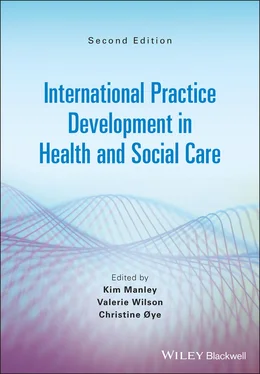More recently, the ‘embedded research’ concept has emerged, a term that can easily describe the systematic role of PD embedded in practice continuously facilitating improvement but also adding to the body of knowledge about what works through participatory, context‐specific research approaches.
In 2008 we argued that PD had come of age:
‘With its focus on person‐centred and evidence‐based workplaces and enabling human‐flourishing, it offers a coherent approach to unravelling the complexity of workplaces and enabling person‐centredness to be realised’
(Manley et al. 2008, p. xix).
So what has changed? Whilst there is much more evidence for the impact of PD on people, their transformation, their teams, users’ experiences, its potential to influence systems more widely is still underutilised. Often managerial cultures or single top‐down methodological approaches ignore the importance of people or are out of synchrony with contemporary approaches to collective leadership where practitioners have an important voice and their expertise is drawn on as a source of social capital.
Independent evidence is now accruing from more traditional research programmes of the impact of compassionate, caring cultures and teams on quality, people’s experiences, staff wellbeing (see Chapter 16) and health outcomes (Dawson 2014, 2018). However, what is not acknowledged in other programmes are the knowledge (both theoretical and practical), the skills and know‐how about how to develop and sustain flourishing cultures in complex health and social care settings. The emphasis on person‐centred care, cultures and systems remains our focus, as does working with complexity and researching practice ‘ with people’ rather than ‘ on people’. The ultimate purpose at the forefront of our work remains the development of health and social care cultures where people flourish.
Living our values as editors and authors
The first edition of International Practice Development in Nursing and Health identified for the first time the principles of PD, distilled from its methodology, methods and key concepts over twenty years.
One of the founding principles of PD first formalised in a realist synthesis of PD methods (McCormack et al. 2007) was ways of working that embrace collaboration, inclusion and participation – termed the ‘CIP’ principle. Whilst previous PD books have enabled multiple authors to work together across countries, this is the first time that the editors have intentionally and explicitly employed the CIP principles to writing chapters, where authors from eight countries across both hemispheres have been invited to co‐create their chapters collaboratively using these principles.
The role of editors over and above the usual focus has been one of facilitation, enabling content to flow and be refashioned through mutual learning, appreciation, critical companionship, connecting through virtual forums and support in enhancing writing skills. For example, two lead authors, senior practitioners, had never written or contributed to a chapter before (in common with many other contributors), but with peer and editor support an effective writing team for each chapter was established, mirroring the support and challenges of the practice world.
PD is about health and social care practice and it is a privilege for the editors to work with so many gifted frontline staff across different settings, most of whom are practitioners, supporting practitioners or are in clinical academic roles as embedded researchers (see Chapter 7).
All contributors have therefore worked to a shared purpose and values but applied these in various chapters to different levels of health and social care and different client groups across life’s spectrum, from birth until older age and end of life.
The person’s/citizen’s voice, in keeping with the values of PD, is strengthened in this edition, so the first chapters following this introduction focus on what matters to people and what involves people working together, co‐creation between those who experience and those who provide care to meet people’s needs as they themselves see them.
The key concepts and structure of the book
We have radically changed the structure of this book compared with its first edition, reversing the theory and practice examples. We start the book with a strong focus on practice and then in the second part look at how theory links to practice. We have reversed this focus because people are inspired by practice‐related stories that demonstrate the impact that PD has. We hope the stories stimulate a deepening interest in the reasons that account for how transformation happens in practice, demystifying the way forward through exploring the key concepts necessary for understanding and use.
The first section, comprising six chapters, describes PD principles in action, either with different client groups or in different settings and system levels. We commence with a focus on the voice of people with stomas and mental health challenges, and how these voices are heard and acted upon in relation to a dedicated health service ( Chapter 2). Chapter 4in contrast focuses on whole communities and what needs to be considered when developing and designing sustainable person‐centred communities and integrated person‐centred systems.
Chapters 3and 5focus on people and their experiences across the life span, from the time surrounding birth and the needs of women and their partners through this transformative experience, moving then to the other end of life to focus on what matters to older people experiencing care in various settings.
As alluded to earlier, PD integrates active learning in and from practice with improving and developing, and also research and inquiry. Chapter 6focuses on the practical use of educational models that embed PD values in practice, exploring the impact of these and how the workplace is a powerful resource for these activities. Chapter 7concludes with examples of embedded research using critical ethnography, an approach commonly used in PD to understand the culture of the workplace collaboratively.
The second part of the book explores PD insights and concepts under four broad interdependent themes:
theoretical perspectives;
facilitation;
leadership;
flourishing cultures.
Developments in our theoretical understanding start with Chapter 8revising the principles of PD originally developed in the 2008 edition. Based on experiences of people across all countries involved in the International Practice Development Collaborative, the revision enables greater clarity about the key purposes and processes of PD, making it more accessible to not just practitioners and those facilitating them but also commissioners and managers who may be better able to employ the distinct and original support PD can provide towards transformation of services and systems.
Much of PD has been based on the theoretical perspective of critical theory from social science. Chapter 9revisits this theory to provide contemporary insights about its use and value.
Chapter 10demystifies facilitation. Facilitation enables others to live their values, learn, and become more person‐centred and compassionate, as well as effective, through self‐awareness from reflection and helping people to understand the impact they have on others. Chapter 11focuses on the multiple purpose of facilitation at different levels in the system.
Three chapters on leadership follow, whereas there was only one in the 2008 edition. This is because leadership in tandem with facilitation is a critical enabler to culture change at every level of health and social care. Everyone can be a leader on something and often we become followers and leaders to each other at different times in different contexts. Chapter 12focuses on relationship‐based leadership approaches; Chapter 13on team leadership to develop flourishing cultures informed by a multiprofessional clinical leadership programme underpinned by PD principles; and Chapter 14on systems leadership.
Читать дальше












